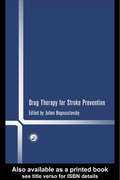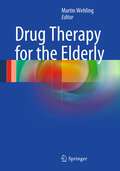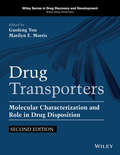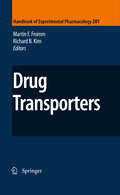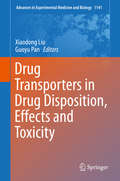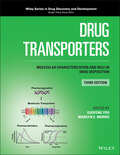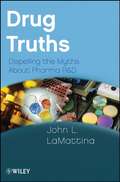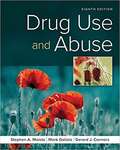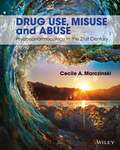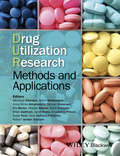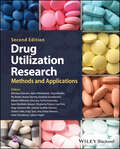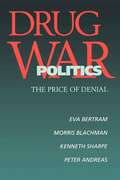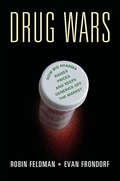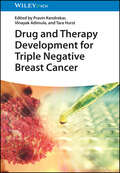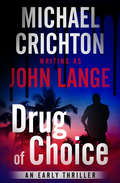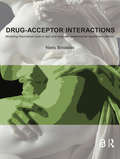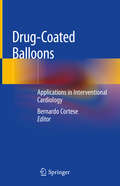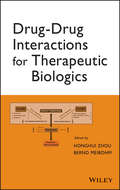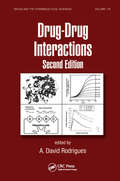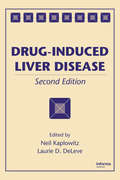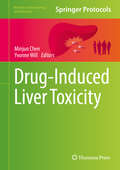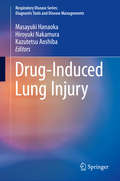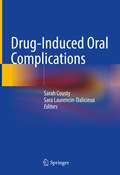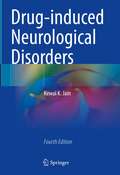- Table View
- List View
Drug Therapy for Stroke Prevention
by Julien BogousslavskyStroke is the third leading cause of death in the USA and UK. It is a major cause of disability among adults and is a significant factor in dementia in later life and its incidence is on the rise. This book discusses specific medications that target the blood and vasculature and how these treatments can be used to complement other therapeutic measu
Drug Therapy for the Elderly
by Martin WehlingWith people aged 65 years and older currently making up the fastest growing age group throughout the world, the demographic revolution of an aging society will inevitably lead to increased pressure to develop a rationalistic and age-tailored process of diagnosis and treatment among the elderly. As aging people often suffer from several chronic diseases and are being treated with multiple medications concurrently, unwanted drug interactions occur more frequently. Whereas recent approaches have recommended to remove particular drugs from the medication regimen to avoid adverse effects, Drug Therapy for the Elderly underlines both indispensable and dispensable elements of drug treatment in order to provide an overall assessment of drugs suitable for the aged. In view of the multimorbidity and polypharmacy situations experienced by elderly patients, this book takes into account the special needs and requirements shown by this group, thus serving as a timely reference for physicians who treat the elderly.
Drug Toxicity and Metabolism in Pediatrics
by Sam KacewThe aim of this text is to examine the physiological development of the fetus. It allows the reader to study the unique pharmacokinetic and metabolic features of newborns and gives specific examples of drug metabolism in the newborn. The purpose of this book is to enhance the current knowledge of pharmacology of the newborn by observing the embryo and placenta in normal and abnormal development, placental transfer of drugs, metabolic pathways, and metabolism of specific drugs such as theophylline, benzodiazepines, and antibiotics. This is a useful book for those involved in pediatric research, pharmacology, toxicology, experimental therapeutics and biology.
Drug Transporters
by Binghe Wang Guofeng You Marilyn E. MorrisThis new edition overviews drug transporters and presents the principles of drug transport and associated techniques, featuring new chapters on multidrug and toxin extrusion proteins, placental transport, in silico approaches in drug discovery, and regulatory guidance for drug transport studies in drug development. * Describes drug transporter families, mechanisms, and clinical implications along with experimental methods for studying and characterizing drug transporters * Includes new chapters on multidrug and toxin extrusion proteins, placental transport and in silico approaches in drug discovery * Has a new chapter covering regulatory guidance for the evaluation of drug transport in drug development with global criteria used for drug transporters in clinical trials * Arranges material to go from fundamental mechanisms to clinical outcomes, making the book useful for novice and expert readers
Drug Transporters
by Richard B. Kim Martin F. FrommIt is increasingly recognized that various transporter proteins are expressed throughout the body and determine absorption, tissue distribution, biliary and renal elimination of endogenous compounds and drugs and drug effects. This book will give an overview on the transporter families which are most important for drug therapy. Most chapters will focus on one transporter family highlighting tissue expression, substrates, inhibitors, knock-out mouse models and clinical studies.
Drug Transporters in Drug Disposition, Effects and Toxicity (Advances in Experimental Medicine and Biology #1141)
by Xiaodong Liu Guoyu PanThis book provides with a comprehensive overview of the role of drug transporters in drug disposition and efficacy/toxicity, as well as drug-drug interactions and recent advances in the field. Transporters are known determinants of drug disposition and efficacy/toxicity. In general, they are divided into solute carrier (SLC) and ATP binding cassette (ABC) families, and are located along cell membranes, where they mediate drug uptake into cells and export out of cells. Drug transporters are essential in maintaining cell homeostasis, and their gene mutations may cause or contribute to severe human genetic disorders, such as cystic fibrosis, neurological disease, retinal degeneration, anemia, and cholesterol and bile transport defects. Conversely, some diseases may also alter transporter functions and expressions, in turn aggravating disease process. Further, since over-expression of some ABC transporters is a potential contributor to multidrug-resistance (MDR), the book presents a number of strategies to overcome MDR, including ABC transporter inhibitors and applying epigenetic methods to modulate transporter expressions and functions. This book is useful for graduate students and professionals who are looking to refresh or expand their knowledge of this exciting field.
Drug Transporters: Molecular Characterization and Role in Drug Disposition (Wiley Series in Drug Discovery and Development)
by Binghe WangDRUG TRANSPORTERS Drug transporter fundamentals and relevant principles and techniques, featuring new and expanded chapters Drug Transporters: Molecular Characterization and Role in Drug Disposition provides in-depth analysis of the conceptual evolution and technical development for studying drug transporters. Contributions by an international panel of leading researchers address advances in transporters as drug targets, transporters in pharmacotherapy, the impact of transporters on drug efficacy and safety, the development of sophisticated model systems and sensitive assay methods, and more. Divided into two parts, the book first provides a thorough overview of relevant drug transporters before detailing the principles of drug transport and associated techniques. The updated and expanded third edition includes new chapters on in vitro-in vivo scale-up of drug transport activities, the ontogeny of drug transporters, the application of physiologically-based pharmacokinetic and pharmacodynamic modeling, and the use of transporters as therapeutic targets for diseases. Reflects the current state of the field and offers perspectives on future directions Covers basic knowledge, clinical outcomes, and emerging discoveries in transporter science Provides up-to-date information on drug transporter families, mechanisms, and clinical implications Includes extensive references and numerous figures and tables throughout Understandable for novices while offering sufficient depth for more experienced researchers, Drug Transporters: Molecular Characterization and Role in Drug Disposition, Third Edition is an excellent textbook for pharmacological or physiological science courses in drug/membrane transport, and an invaluable reference for academic or industrial scientists working in the transporter field and related areas of drug metabolism, pharmacokinetics, and pharmacodynamics.
Drug Truths
by John L. LamattinaAn insider's perspective on the pharmaceutical industry It's easy to hate Big Pharma. After all, they charge a lot of money for life-saving drugs. You could argue that Big Pharma's incentive to generate income is antithetical to the needs of society. But, if you set costs aside, no reasonable person could argue against the industry's accomplishments. The pharmaceutical industry has cured many infectious diseases and some cancers, delayed the onset of heart disease, enabled AIDS patients to live long and productive lives, controlled the progression of arthritis, and reduced pain. Any thoughtful discussion on the pharmaceutical industry must be guided by the facts. Author John LaMattina, a thirty-year veteran and former president of Pfizer Global Research and Development, takes you through the realities and the myths surrounding the pharmaceutical industry, offering concrete illustrative examples. Rather than innuendo, he offers facts, answering your questions about the process and costs of pharmaceutical R&D in a compelling narrative focused on the discovery and development of new medicines. Divided into four parts, this book dispels common misconceptions, helping you arrive at your own informed conclusions: Part One, A Matter of the Heart Part Two, The Role of Pharmaceutical R&D in Healthcare Part Three, The Profit Motive Part Four, The Future With its emphasis on fact, John LaMattina's book is indispensable for anyone interested in understanding, advocating, or setting pharmaceutical policy, including general consumers, pharmaceutical executives, regulators, pharmaceutical researchers, and students. "This is an important and timely book. " -Dr. Richard A. Lerner, President of the Scripps Research Institute "Drug Truths is an authoritative, clear, and accessible exposition of the realities of drug discovery and development. " -Professor E. J. Corey, Nobel Laureate, Harvard University
Drug Use And Abuse (Mindtap Course List Ser.)
by Gerard J. Connors Stephen A. Maisto Mark GalizioDid you know that a drug's effects depend not only on its properties but also on the biological and psychological characteristics of its user? This theme is highlighted throughout DRUG USE AND ABUSE, 8th Edition. The book weaves historical, social, psychological, cultural, biological, and medical perspectives, taking an interdisciplinary approach in its coverage of current topics regarding drug use, problems associated with use, and their prevention and treatment. You'll learn about classes of drugs as well as the latest data on drug use patterns and social trends, such as the recent increase in heroin addiction, the altered social and legislative environment surrounding marijuana, and the use of technology in the treatment of the substance use disorders.
Drug Use, Misuse, And Abuse
by Cecile MarczinskiBringing a new approach to covering the basic principles and major topics found in a typical psychopharmacology course, Drug Use, Misuse and Abuse also adds the newest exciting and controversial findings in the study of drug use and abuse. At the core, the text has a strong emphasis on developing scientific literacy and critical thinking in the student. <p><p> Drug Use, Misuse and Abuse includes the major drugs typically covered in an undergraduate psychopharmacology course (caffeine, nicotine, cocaine, amphetamines including methamphetamine, alcohol, opiates, marijuana, the hallucinogens, antipsychotics, antidepressants, and antianxiety medications) and, moreover, the content emphasizes the latest scientific findings in the field, including advances in imaging the living brain. Included is a chapter on careers related to psychopharmacology, as well as a variety of pedagogical features that help students learn, making it appropriate for an instructor of a lecture-based, online or hybrid course.
Drug Utilization Research: Methods and Applications
by Monique Elseviers Elisabetta Poluzzi Kstja Taxis Vera Vlahoviæ-Palèevski Robert Vander Stichele Bjö Wettermark Anna Birna Almarsdóttir Morten Andersen Ria Benko Marion Bennie Irene Eriksson Brian Godman Janet KrskaDrug Utilization Research (DUR) is an eclectic scientific discipline, integrating descriptive and analytical methods for the quantification, understanding and evaluation of the processes of prescribing, dispensing and consumption of medicines and for the testing of interventions to enhance the quality of these processes. The discipline is closely related and linked mainly to the broader field of pharmacoepidemiology, but also to health outcomes research, pharmacovigilance and health economics. Drug Utilization Research is a unique, practical guide to the assessment and evaluation of prescribing practices and to interventions to improve the use of medicines in populations. Edited by an international expert team from the International Society for Pharmacoepidemiology (ISPE), DUR is the only title to cover both the methodology and applications of drug utilization research and covers areas such as health policy, specific populations, therapeutics and adherence.
Drug Utilization Research: Methods and Applications (Advances In Pharmaceutical Technology Ser.)
by Dennis Douroumis Dimitrios A. Lamprou Sheng QiTowards a better understanding of how medicines are used in society Drug Utilization Research (DUR) is a discipline which combines aspects of pharmacotherapy, epidemiology, and health services research into an interdisciplinary set of methods for analyzing and assessing the prescribing, dispensing and consumption of medicines. It combines both qualitative and quantitative approaches to facilitate the safe and effective use of pharmaceuticals. Drug Utilization Research: Methods and Applications provides a comprehensive introduction to this discipline, prepared by an international team of authors with broad experience in numerous fields. Now reorganized and updated to reflect the latest research and global challenges, it is an indispensable resource for understanding the use of pharmaceuticals. Readers of the second edition of Drug Utilization Research will find: New chapters on methods, including more hands-on guidance on how to plan and conduct different types of drug utilizationA section on specific applications in areas such as psychotropics, opioids, cancer drugs, antibacterials, and cardiovascular drugsA new section with case studies illustrating applications of DUR in different continentsDetailed treatment of subjects including DUR and health policy, DUR in specific populations, and many more Drug Utilization Research is ideal for epidemiologists, pharmacists, physicians, nurses and others interested in drug use and its outcomes.
Drug War Politics: The Price Of Denial (Emersion: Emergent Village Resources For Communities Of Faith Ser.)
by Peter Andreas Kenneth Sharpe Eva Bertram Morris BlachmanWhy have our drug wars failed and how might we turn things around? Ask the authors of this hardhitting exposè of U.S. efforts to fight drug trafficking and abuse. In a bold analysis of a century's worth of policy failure, Drug War Politics turns on its head many familiar bromides about drug politics. It demonstrates how, instead of learning from our failures, we duplicate and reinforce them in the same flawed policies. The authors examine the "politics of denial" that has led to this catastrophic predicament and propose a basis for a realistic and desperately needed solution. Domestic and foreign drug wars have consistently fallen short because they are based on a flawed model of force and punishment, the authors show. The failure of these misguided solutions has led to harsher get-tough policies, debilitating cycles of more force and punishment, and a drug problem that continues to escalate. On the foreign policy front, billions of dollars have been wasted, corruption has mushroomed, and human rights undermined in Latin America and across the globe. Yet cheap drugs still flow abundantly across our borders. At home, more money than ever is spent on law enforcement, and an unprecedented number of people―disproportionately minorities―are incarcerated. But drug abuse and addiction persist. The authors outline the political struggles that help create and sustain the current punitive approach. They probe the workings of Washington politics, demonstrating how presidential and congressional "out-toughing" tactics create a logic of escalation while the criticisms and alternatives of reformers are sidelined or silenced. Critical of both the punitive model and the legalization approach, Drug War Politics calls for a bold new public health approach, one that frames the drug problem as a public health―not a criminal―concern. The authors argue that only by situating drug issues in the context of our fundamental institutions―the family, neighborhoods, and schools―can we hope to provide viable treatment, prevention, and law enforcement. In its comprehensive investigation of our long, futile battle with drugs and its original argument for fundamental change, this book is essential for every concerned citizen.
Drug Wars: How Big Pharma Raises Prices and Keeps Generics off the Market
by Robin Feldman Evan FrondorfWhile the shockingly high prices of prescription drugs continue to dominate the news, the strategies used by pharmaceutical companies to prevent generic competition are poorly understood, even by the lawmakers responsible for regulating them. In this groundbreaking work, Robin Feldman and Evan Frondorf illuminate the inner workings of the pharmaceutical market and show how drug companies twist health policy to achieve goals contrary to the public interest. In highly engaging prose, they offer specific examples of how generic competition has been stifled for years, with costs climbing into the billions and everyday consumers paying the price. Drug Wars is a guide to the current landscape, a roadmap for reform, and a warning of what is to come. It should be read by policymakers, academics, patients, and anyone else concerned with the soaring costs of prescription drugs.
Drug and Therapy Development for Triple Negative Breast Cancer
by Pravin Kendrekar Vinayak Adimule Tara HurstDrug and Therapy Development for Triple Negative Breast Cancer The first comprehensive and up-to-date compilation of modern diagnostic and treatment methods for triple negative breast cancer In Drug and Therapy Development for Triple Negative Breast Cancer, a team of distinguished practitioners delivers an in-depth and authoritative discussion of contemporary methods for treating triple negative breast cancer (TNBC). The editors have included material that covers its molecular causes, initial detection, diagnostic tools, treatment procedures, pharmacology, and new and experimental therapies—including nanotherapeutics and photothermal therapies. As the first comprehensive compilation of modern treatment methods for TNBC, this reference is an unmatched source of information about current and future treatment approaches, including machine learning methods for earlier detection and more accurate diagnosis. Readers will also find: A thorough introduction to HER receptors in breast cancers Comprehensive explorations of the etiology and therapy of hormone receptor-positive breast cancer and the early-stage diagnosis of breast cancer Application of artificial intelligence to breast cancer diagnosis New insights on the role of DNA replication stress and genome instability in breast cancer Perfect for medicinal and pharmaceutical chemists, Drug and Therapy Development for Triple Negative Breast Cancer will also benefit oncologists and professionals working in the pharmaceutical industry or in hospital settings.
Drug of Choice: A Novel
by Michael Crichton John LangeTo uncover the secrets of a superdrug, a doctor must go undercover and risk it all . . .When a Hell's Angel is thrown from his bike at 110 miles per hour, he should probably end up in the morgue. But this Angel survives his crash without a scratch, and ends up sleeping peacefully in the hospital. When Dr. Roger Clark inspects him, he finds only one defect: blue urine. Similar reports start to trickle in from hospitals upstate. It seems that a strange new drug is sending people into comas, and only Clark can unravel its mystery.His search for answers takes him on the strangest trip of his life, into a place called "Eden," which looks like paradise, but feels like hell.This ebook features an illustrated biography of Michael Crichton including rare images from the author's estate.
Drug-Acceptor Interactions: Modeling Theoretical Tools to Test and Evaluate Experimental Equilibrium Effects
by Niels BindslevDrug-Acceptor Interactions: Modeling theoretical tools to test and evaluate experimental equilibrium effects suggests novel theoretical tools to test and evaluate drug interactions seen with combinatorial drug therapy. The book provides an in-depth, yet controversial, exploration of existing tools for analysis of dose-response studies at equilibrium or steady state. The book is recommended reading for post-graduate students and researchers engaged in the study of systems biology, networks, and the pharmacodynamics of natural or industrial drugs, as well as for medical clinicians interested in drug application and combinatorial drug therapy. Even people without mathematical skills will be able to follow the pros and cons of reaction schemes and their related distribution equations. Chapter 9 is a hands-on guide for software to plot, fit and analyze one’s own data.
Drug-Coated Balloons: Applications in Interventional Cardiology
by Bernardo CorteseThis book provides a comprehensive, up-to-date summary of drug-coated balloon (DCB) technology and the role of DCBs in the treatment of coronary and peripheral arterial disease. In addition to clear explanation of how DCBs works, readers will find an enlightening analysis of the mistakes and successes of the past decade and the emergence of the latest delivery systems, which combine a more deliverable device with much improved drug delivery to the vessel wall. The full range of current applications of DCBs are reviewed in detail, drawing on the latest scientific evidence. Due attention is paid to newer devices, with provision of technical insights and documentation of the available clinical data. Ongoing research projects, remaining technical challenges, likely future directions, and reimbursement issues are also carefully considered. This book will be a useful tool for any interventional cardiologist, interventional radiologist, or vascular surgeon who wishes to acquire a deep knowledge of this technology and its application in both coronary and peripheral interventions.
Drug-Drug Interactions for Therapeutic Biologics
by Bernd Meibohm Honghui ZhouStrategize, plan, and execute comprehensive drug-drug interaction assessments for therapeutic biologicsOffering both theory and practical guidance, this book fully explores drug-drug interaction assessments for therapeutic biologics during the drug development process. It draws together and analyzes all the latest findings and practices in order to present our current understanding of the topic and point the way to new research. Case studies and examples, coupled with expert advice, enable readers to better understand the complex mechanisms of biologic drug-drug interactions.Drug-Drug Interactions for Therapeutic Biologics features contributions from leading international experts in all areas of therapeutic biologics drug development and drug-drug interactions. The authors' contributions reflect a thorough review and analysis of the literature as well as their own firsthand laboratory experience. Coverage includes such essential topics as:Drug-drug interaction risks in combination with small molecules and other biologicsPharmacokinetic and pharmacodynamic drug-drug interactionsIn vitro methods for drug-drug interaction assessment and predictionRisk-based strategies for evaluating biologic drug-drug interactionsStrategies to minimize drug-drug interaction risk and mitigate toxic interactionsKey regulations governing drug-drug interaction assessments for therapeutic biologics.Drug-Drug Interactions for Therapeutic Biologics is recommended for pharmaceutical and biotechnology scientists, clinical pharmacologists, medicinal chemists, and toxicologists. By enabling these readers to understand how therapeutic biologics may interact with other drugs, the book will help them develop safer, more effective therapeutic biologics.
Drug-Drug Interactions: Progress And Future Challenges (Drugs And The Pharmaceutical Sciences Ser.)
by A. David RodriguesAuthored by renowned leaders in the field, this comprehensive volume covers all aspects of drug-drug interactions, including preclinical, clinical, toxicological, and regulatory perspectives.Thoroughly updated, this second edition reflects the significant advances and includes extensive new material on:key interplay between transporters and enzymes
Drug-Induced Liver Disease
by Neil Kaplowitz Laurie D. DeLeveFeaturing more than 4100 references, Drug-Induced Liver Disease is an invaluable reference for gastroenterologists, hepatologists, family physicians, internists, pathologists, pharmacists, pharmacologists, and clinical toxicologists, and graduate and medical school students in these disciplines. This book supplies an in-depth discussion of drug-ind
Drug-Induced Liver Toxicity (Methods in Pharmacology and Toxicology)
by Yvonne Will Minjun ChenThis book provides a comprehensive view of the methodologies used for the study of liver toxicity encountered throughout the whole life cycle of a drug, from drug discovery, to clinical trial, post-marketing, and even clinical practice. Organized into six sections, the first section introduces the mechanisms contributing to drug-induced liver toxicity. The second and third section explore in silico and in vitro approaches used to help mitigate hepatotoxicity liability at the early stages of drug development. The fourth section describes methodologies applied in regulatory processes, including preclinical studies, clinical trials, and post-marketing surveillance. The fifth section discusses clinical hepatotoxicity. Emerging technologies are examined in the final section. As a volume in the Methods in Pharmacology and Toxicology series, chapters include the kind of expert advice that will lead to optimal results. Authoritative and practical, Drug-Induced Liver Toxicity serves all those who aim to improve assessment and understanding of hepatotoxic potentials of new medications and marketed drugs.Chapter 30 is open access under a CC BY 4.0 license via link.springer.com.
Drug-Induced Lung Injury
by Hiroyuki Nakamura Kazutetsu Aoshiba Masayuki HanaokaThis book covers various aspects of a respiratory system disorder associated with prescribed drugs that do not yet have established treatment guidelines, and for which the only treatment is to discontinue taking the drug. Very little clinical evidence regarding the disorder is available, since randomized trials cannot to be carried out, the onset of the disorder cannot be predicted, and the resulting pathological condition is life-threatening. However, the need for an established treatment continues to grow due to the introduction of many new drugs, such as anti-neoplastic drugs, biological products, and molecular target drugs, the adverse effects of which are difficult to differentiate from those of other lung diseases, such as lung infectious diseases. Drug-Induced Lung Injury offers a highly beneficial resource not only for respiratory physicians but also all medical clinicians who prescribe drugs, nurses, pharmacists and pharmaceutical scientists. Written by pioneering experts in the field, the book examines a wealth of cases and the insights they yield concerning the diagnosis, treatment and specific drugs causing the disease. It not only fosters a deeper understanding of the disorder but also highlights the current challenges and paves the way for future clinical research.
Drug-Induced Oral Complications
by Sarah Cousty Sara Laurencin-DalicieuxThis book provides detailed information on the prevalence and manifestations of the most important oral complications associated with different drug treatments, focusing especially on recently developed therapies. Among the diverse adverse drug reactions covered are gingival overgrowth, ulcerations, lichenoid reactions, pigmentation, and bullous reactions. The potential direct toxic effects on bone of drugs that prevent bone mass loss, such as bisphosphonates and denosumab, are fully examined, as is the occurrence of spontaneous oral bleeding in patients receiving antithrombotic therapies. Further chapters focus on drug-induced taste disorders and salivary gland disturbances, including xerostomia, swelling, and hypersalivation. The enhanced risk of oral infections when using chemotherapy and biotherapy is addressed, and the closing chapter examines drug-related perioral and facial complications. This book is a collaborative work that brings together clinicians, surgeons, and specialists in drug safety surveillance. It will be of value for all dental and medical practitioners who encounter these complications in their clinical practice.
Drug-induced Neurological Disorders
by Kewal K. JainThis book is a first-of-its kind reference that systematically organizes and describes the adverse effects of drugs on the nervous system. Drug safety is recognized as an important aspect of pharmaceutical companies as well as practice of medicine. Chapters include case reports of adverse effects of drugs that are published as well as reported to drug manufacturers. The book scope is broad as it covers lack of efficacy, drug resistance, drug-disease and drug-drug interactions. This information is used to improve the use of drugs as well as to design better and safer drugs for the future, and is relevant to personalized medicine in trying to match the right drugs to the patients.Drug-induced Neurological Disorders offers a unique approach to this important topic by integrating clinical neurology with pharmacology with a focus on effects of drugs on the nervous system including those used for the treatment of neurological disorders as well systemic diseases. Many adverse effects involve multiple systems of the body and the syndromes with predominant effect on the nervous system are included in this book.
